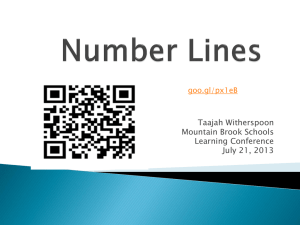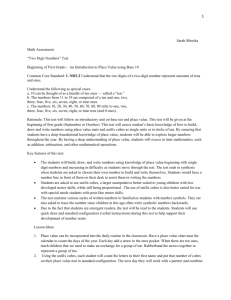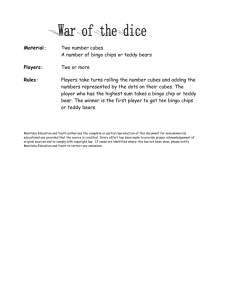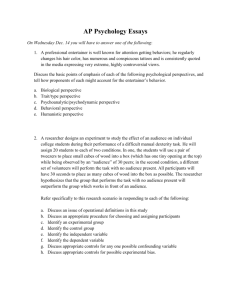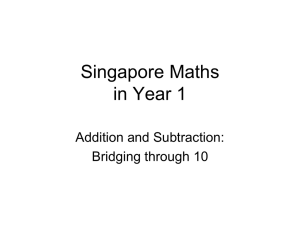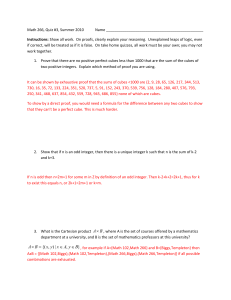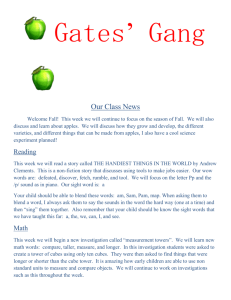Place Value Interview Handout Page
advertisement
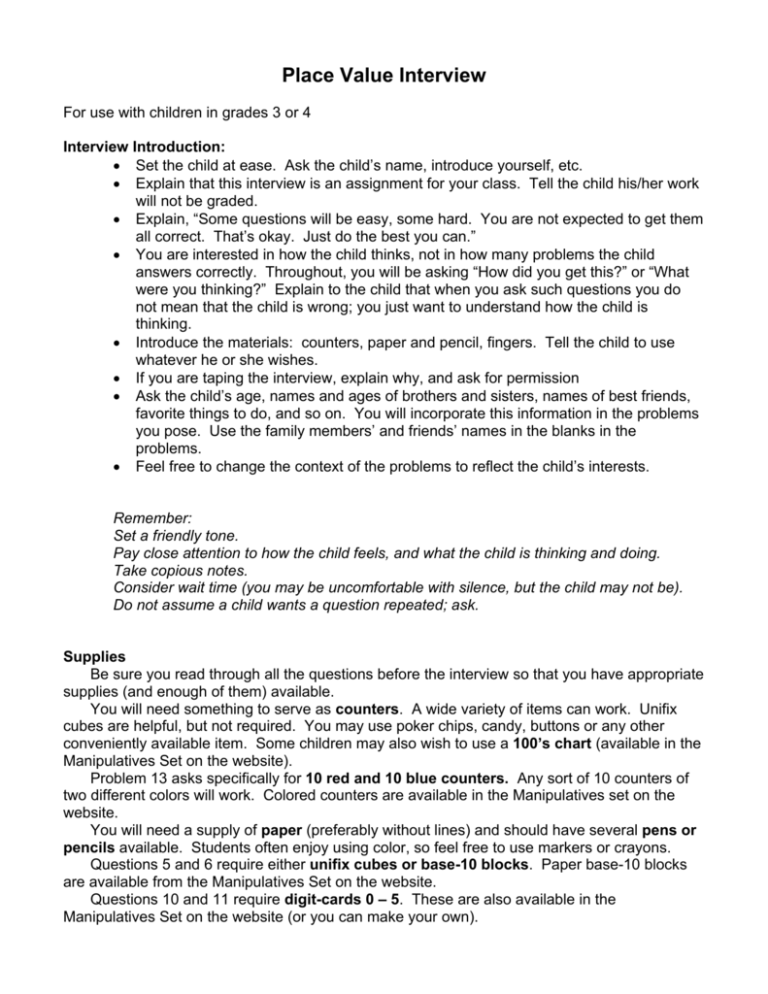
Place Value Interview For use with children in grades 3 or 4 Interview Introduction: • Set the child at ease. Ask the child’s name, introduce yourself, etc. • Explain that this interview is an assignment for your class. Tell the child his/her work will not be graded. • Explain, “Some questions will be easy, some hard. You are not expected to get them all correct. That’s okay. Just do the best you can.” • You are interested in how the child thinks, not in how many problems the child answers correctly. Throughout, you will be asking “How did you get this?” or “What were you thinking?” Explain to the child that when you ask such questions you do not mean that the child is wrong; you just want to understand how the child is thinking. • Introduce the materials: counters, paper and pencil, fingers. Tell the child to use whatever he or she wishes. • If you are taping the interview, explain why, and ask for permission • Ask the child’s age, names and ages of brothers and sisters, names of best friends, favorite things to do, and so on. You will incorporate this information in the problems you pose. Use the family members’ and friends’ names in the blanks in the problems. • Feel free to change the context of the problems to reflect the child’s interests. Remember: Set a friendly tone. Pay close attention to how the child feels, and what the child is thinking and doing. Take copious notes. Consider wait time (you may be uncomfortable with silence, but the child may not be). Do not assume a child wants a question repeated; ask. Supplies Be sure you read through all the questions before the interview so that you have appropriate supplies (and enough of them) available. You will need something to serve as counters. A wide variety of items can work. Unifix cubes are helpful, but not required. You may use poker chips, candy, buttons or any other conveniently available item. Some children may also wish to use a 100’s chart (available in the Manipulatives Set on the website). Problem 13 asks specifically for 10 red and 10 blue counters. Any sort of 10 counters of two different colors will work. Colored counters are available in the Manipulatives set on the website. You will need a supply of paper (preferably without lines) and should have several pens or pencils available. Students often enjoy using color, so feel free to use markers or crayons. Questions 5 and 6 require either unifix cubes or base-10 blocks. Paper base-10 blocks are available from the Manipulatives Set on the website. Questions 10 and 11 require digit-cards 0 – 5. These are also available in the Manipulatives Set on the website (or you can make your own). The Interview 1. [ [ ] has 14 toy cars. He gives 5 toy cars to his/her friend. How many toy cars does ] have left? 2. [ ] had 6 marbles. How many more marbles does [ together? ] need to buy to have 13 all 3. A pack of gum has 5 pieces. How many pieces of gum would you have altogether if you had 3 packs of gum? 4. Twenty children are to be driven to the park. If each car had seat belts for only 4 children, how many cards would be needed to drive all 20 children to the park? (Unifix cubes or base 10 blocks are needed for questions 5 and 6. Base-10 blocks can be printed out from the Manipulatives Set on the website). 5. (Put out 3 loose cubes and 4 rods of unifix cubes with 10 cubes on each rod – or use 3 units and 4 tens from the base 10 blocks. Show the child that the rods are the same length.) Each of these rods has the same number of cubes. There are 10 cubes in each rod. Do you want to count the cubes in one rod to be sure there are 10? Okay, so there are 10 cubes in each rod. Can you tell me how many cubes there are all together counting all the cubes?” (Sweep your hand over the entire collection) 6. (Put one more rod of 10 down). “Watch what I do. I’m putting 10 more here. Now how many are there?” 7. How many 10’s are in 32? How many tens are in 120? How many ones are in 316? 8. There are 10 candies in a roll. How many candies in 4 rolls? If the child answers “40”, ask, “Forty what?” Ask the child to write the number forty. Ask, “Can you see 4 of something in the 40?” How many candies in 10 rolls? How many candies in 13 rolls? How many candies in 20 rolls? If the child answers 200, ask, “Two hundred what?” Ask the child to write the number two hundred. Ask, “Can you see 20 of something in the 200? 9. (Prepare for this task by counting out a set of 16 counters and writing 16 on a card.) Put out a set of 16 chips; ask the child to count the chips, then to read the numeral written on the card. Circle the 6 and say “Show me that part of the number with the counters.” Circle the 1 and say “Show me that part of the number with the counters.” 10. (Give the child digit cards 0-5 -- available in the manipulatives set on the website). Ask the child to make the largest 2-digit number possible from those cards. Ask the child to make the largest 3-digit number possible from those cards. Ask the child to make the largest possible number from those cards. 11. (Give the child digit cards 0-5) Ask the child to make the largest SUM possible from five of those cards. Show the child the work of another child Robert (which you have written out ahead of time). 2 + 0 1 5 3 Ask the child whether Robert has used the cards to make the largest possible sum. If the child says that he has not, ask the child to arrange the cards to make the largest possible sum. 12. (Prepare for this task by arranging 13 counters as three groups of four objects and on left over object. Write 13 on a card.) Circle the 3 on the card and ask the student to show that part of the number with the counters. Circle the 1 on the card and ask the student to show that part of the number with counters. 13. (Put out 10 blue and 10 red counters – available in the Manipulatives Set on the website). Explain that each blue = 1 point and each red = 10 points. Show a card with the number 32 on it. Say, “Show that many points with cubes.” Ask the child to show you another way to show that many points with cubes. (Present the following problems written HORIZONTALLY. (For many students, writing the problem vertically will automatically trigger the use of the standard algorithm). Say, “Can you find the answer to these, thinking only in your head?” (Once the child provides an answer, ask them to explain their thinking). 14. 99 + 96 15. 49 + 54 16. 29 + 30 + 31 17. 100 – 52 18. (Present the following problem in the traditional vertical format. If the child solves the problem using the standard algorithm, ask what the regrouped 1 stands for. If the child says, “One,” follow up with “There is a 1 down here (pointing to 1 in the answer). Does this 1 (the regrouped 1) have the same value as this 1 (the one in the answer)?” 34 +57 19. A child named Julio worked the problem this way. What do you think of Julio’s work? 34 +57 80 11 91 (If the child needs help understanding Julio’s way, say “3 tens plus 5 tens is 8 tens or 80, 4 ones plus 7 ones is 11 80 plus 11 is 91) Do you think you understand? Can you apply Julio’s approach to another problem? 32 +26 38 +45 If the child cannot use Julio’s method for these problems, use base 10 blocks to demonstrate how Julio’s method works. 20. Can you try Julio’s method for this problem? 638 +476 21. Can you solve this problem? (The student may use any method necessary. If they use the standard algorithm, ask if they can solve it another way). 70 – 23


